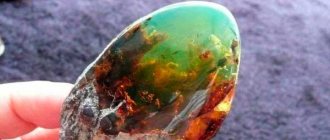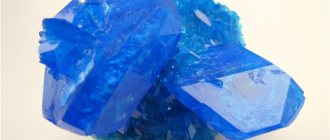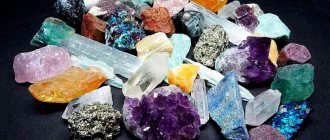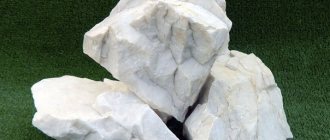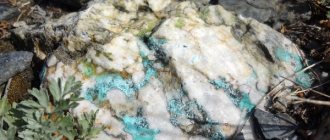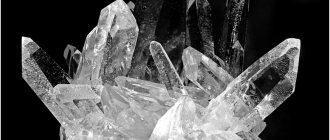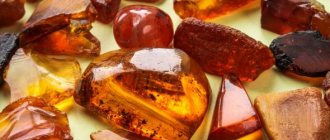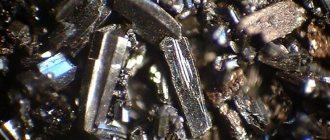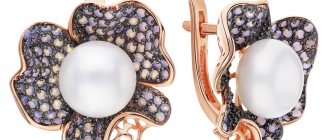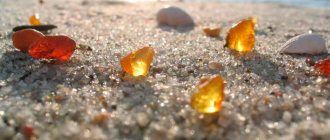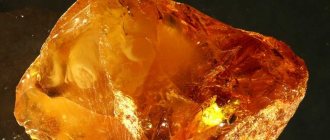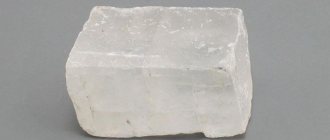The value of minerals is determined by many criteria, including the degree of their hardness. The harder the stone, the higher its value.
Hardness is the ability of a stone to withstand mechanical stress. Mechanical impact refers to various actions: impacts, scratches, friction, indentations, etc.
There are two criteria for assessing the strength of stones: the absolute criterion and the Mohs scale (relative).
The hardness of precious minerals is measured using the Mohs scale. This measurement means comparing the hardness of a new mineral with existing reference hard stones. For this procedure, a smooth zone is marked on the stone and the sharp corner of the reference stone is drawn along it, pressing it firmly. If no scratches remain in the test area of the stone, take a harder stone and scratch it, etc. They do this until a scratch forms on the stone. By comparing it with standard stones, the hardness of which is already known, conclusions are drawn.
The strongest stone is...
Nature has created a huge number of different minerals. Some of them are so soft that they crumble in your hands. But others do not deform even from the strongest blow. What is the strongest stone in nature? Let's figure it out.
If we talk exclusively about minerals, the answer is obvious - it is diamond. This natural formation is one of the forms of pure carbon, which is formed in the bowels of the Earth at significant depths. The mineral is at the top of the Mohs scale with an absolute hardness of 1600 units. In addition, diamond also has such a quality as metastability (that is, the ability to exist for an unlimited period of time under normal environmental conditions).
It is worth noting that the word “stone” can also mean such a concept as rock (an aggregate of one or more types of minerals). Determining the absolute record holder for hardness among rocks is not so easy. Most often, the following rocks are included in the list of the most durable stones:
- Gabbro.
- Diabase.
- Granite.
However, further in our article we will pay special attention to diamond - the most durable stone among mineral formations.
Difficulties of cutting
It is worth noting that cutting a diamond is not only a complex, but also a very long process. Large stones can be processed for several months, while unique ones can take several years. During these operations, the weight of the diamond can be reduced by three or two times, but the cost of the stone itself increases much more.
Therefore, jewelers must be not only good craftsmen, but also excellent mathematicians. Before processing begins, the future shape of the diamond is carefully calculated with the condition of maximum light transmission and preservation of the greatest mass. However, if previously jewelers had to do everything manually, now they are greatly helped by computers that allow them to automate this process.
Mineral diamond: basic properties
So, the most expensive, most desirable, most beautiful and most durable stone on Earth is diamond. And it's hard to argue with that. However, the very name of this mineral is more than eloquent. The word “diamond” translated from ancient Greek means “indestructible.”
The first historical evidence of a transparent stone of unprecedented strength came to us from Ancient India and China. At the same time, the Hindus called him Phariya. But the Chinese, back in the third millennium BC, used diamonds to polish their ceremonial axes made of corundum.
What physical and mechanical properties does the strongest stone in the world have? Let's list the most basic of them:
- Gloss: diamond.
- Trait color: none.
- Hardness: 10 (Mohs scale).
- Density: 3.47-3.55 g/cm3.
- Fracture: conchoidal to splintered.
- Syngony: cubic.
- Thermal conductivity: 900-2300 W/(m K) (very high).
The most common color of diamonds is yellow or colorless. The least common minerals found in nature are green, blue, red or black. Another important property of all diamonds is their ability to luminesce. When exposed to sunlight, they begin to glow and shimmer in different colors and shades.
Titanium alloys
They are used in industry and mechanical engineering. Lightweight and durable, titanium is the main element of alloys that are highly resistant to corrosion. But they have a very high cost.
Therefore, titanium alloys are used mainly for high-tech production. There are titanium deposits in different countries, including Russia.
Urgant on why a woman should always be unpredictable (even in marriage)
New cross-border walking trail allows you to explore Baltic forests (Video)
Who really was Ivan Fedorov and why did he escape from Moscow to Lithuania?
Main diamond deposits
Diamonds are formed at a depth of 80-150 kilometers under the influence of colossal pressure and temperature. Then, thanks to volcanic activity, they rise closer to the surface of our planet, forming vertical deposits - kimberlite pipes. For example, this is what the neck of such a pipe looks like in Yakutia (Mir diamond quarry):
In addition, some diamonds may also be of meteorite origin. Such minerals are formed when a cosmic body comes into contact with the surface of the Earth. Thus, “extraterrestrial diamonds” were discovered in the Grand Canyon in the USA.
It just so happens that the richest diamond deposits on Earth are concentrated in the depths of Africa. This is where the largest mineral mining company in the world, De Beers, is based. Diamonds today are actively mined in South Africa, Angola, Botswana, Namibia, Tanzania, Russia, Canada, and Australia. The leader of the Russian diamond industry is.
Labradorite
Labradorite is a deep-seated coarse-crystalline rock consisting of plagioclase with an admixture of dark minerals contained in the rock from 2 to 25% (pyroxene, olivine and titanic iron ore - ilmenite).
There are two types of labradorite - almost black in the form of lacy black crystals with a dark blue, golden, and sometimes reddish tint. The second variety of labradorite is light gray with large plagioclase crystals; its color is distinguished by a delicate play of blue tones. Color dark gray, greenish gray, bluish gray.
A characteristic feature of labradorite is irradiation (shimmer) - the formation of reflections on the polished surface of feldspar grains caused by inclusions of the mineral ilmenite. The colors of the shimmering crystals are blue, light blue and gold, the crystal sizes are 10-15 cm.
Labradorite is easier to process than granite due to its viscosity. Labradorites with a grain size of 6-7 mm are better processed. Compressive strength from 1000 to 2000 kg/cm2, volumetric mass 2340 kg/m3.
Application of diamonds in industry
Do not think that diamonds are used exclusively in jewelry. The hardest stone is also widely used in industry. In particular, heavy-duty drills, knives, cutters and other products are made from it. Diamond powder (essentially waste obtained from processing natural diamonds) is used as an abrasive in the production of sharpening discs and wheels.
Diamonds are also used in nuclear energy and quantum electronics. Another extremely promising area these days is microelectronics on diamond substrates.
Granite, gabbro and other hard rocks
Everyday ideas about the hardness and other properties of natural stone are most often based on information from popular sources and popular opinions of “experts” - you can cut food on a granite countertop, granite and marble tiles on the bathroom floor, because water, gabbro-diabase paving stones on Red Square because there are tanks. And if this is enough for a general outlook, then more specific knowledge will be required to use this or that rock in construction, finishing work or the production of stone products.
Hardness measurement
Practical applications of rocks have required the development of methods for measuring and assessing their characteristics and properties. Each of the methods used today differs in the method of measurement and has its own application characteristics.
The most famous, simple and accessible method to everyone was proposed by Mohs. It is based on a sequential comparison of a sample with a standard set of minerals. Each of which is harder than the previous one and is capable of leaving a scratch on it. The hardness value of the sample is between the last softer mineral and the first harder one. The scale has 10 divisions (minerals from talc to diamond), it is non-linear, can be used in any conditions, and gives a quick, albeit very approximate result.
Less practical (require laboratory conditions and instruments), but more accurate and based on measurement results, methods and scales were developed by Brinell, Rockwell, Vickers, Shore and Schreiner. They are based on influencing samples by pressing hardened steel balls (Brinell), diamond cones (Vickers) or special punches (Schreiner) into them.
Quartzites
The high hardness (about 8 units on the Mohs scale and up to 8100 MPa on the Schreiner scale) of these fine-grained rocks formed by recrystallization of sandstones is due to the presence in their composition of a significant amount of quartz and secondary minerals - corundum, topaz and others. The variety of colors is also related to their composition - white, yellow, crimson, green, black and blue stones are the result of the action of various mineral impurities.
The extraordinary hardness and high decorative properties of quartzites are the main reasons for their widespread use in architecture, decoration of buildings and premises, road construction work, creation of monuments and even in the manufacture of amulets and talismans.
Granites
Granite formed in the depths of the earth is only slightly inferior to quartzites in hardness (6.5-7 units on the Mohs scale and from 3000 to 6500 MPa on the Schreiner scale). Quartz, feldspars and mica are the main mineral components of granites. In combination with minor minerals, they provide exceptional strength (about 3000 kg/cm2 for fine-grained varieties and up to 1500 kg/cm2 for coarse-grained varieties), a wide range of colors and a variety of textures.
The combination of exceptional physical parameters and external beauty, accessibility for grinding, polishing and other types of processing makes granites a very attractive material for the production of various products. Let us note only the most famous of the products: granite paving slabs , countertops, steps for stairs, polished granite slabs , memorial products.
Gabbro
The formation of this rock took place under conditions even more complex than the formation of granites - at greater depths, at higher temperatures and pressures. gabbro rock (up to 7.2 units on the Mohs scale and up to 4400 MPa on the Schreiner scale). The presence of dark-colored minerals gives the corresponding color - from dark gray to deep black. The absence of quartz in gabbro facilitates polishing, and the presence of relatively transparent plagioclase gives the polished surface a special depth.
The high frost resistance of the rock and resistance to weathering makes it suitable for external cladding - gabbro facade slabs have proven themselves to be excellent finishing and protection for the basement of buildings. High density and good adhesion to bitumen make crushed gabbro one of the best fillers for asphalt concrete.
Basalts
The closest mineralogical composition to gabbro are basalts, the most common volcanic rock on the planet. It makes up ocean ridges, island arcs, continental and oceanic plates. In terms of hardness, it is not inferior to granites (about 7 units on the Mohs scale and 3900 MPa on the Schreiner scale), and the compressive strength reaches 5000 kg/cm2.
A large number of basalt deposits are being developed in Eastern Siberia, Armenia, and the Far East. Their main products are crushed stone, paving stones, and road curbs. Several deposits in Georgia and Armenia supply stone suitable for facing work. Basalt is widely used in the production of mineral wool, and its high resistance to acids and alkalis makes facing tiles made from it an indispensable material for finishing industrial premises.
Syenites
They belong to igneous rocks, of which their share is slightly less than 3%. They are characterized by an almost complete absence of quartz in their composition. They are considered the closest “relatives” of granites, although the hardness of syenites is slightly lower (up to 6 Mohs units and up to 5700 MPa according to Schreiner). The main applications are similar to granites - construction, production of ceramics and glass, soda and cement.
Diabases
They are paleotype analogues of basalt and gabbro; they contain forming minerals - plagioclase, augite, as well as hornblende and quartz in the form of impurities. In terms of hardness it is closer to granites (6-7 units on the Mohs scale and from 1500 to 5000 MPa on the Schreiner scale). High compressive strength (up to 300 MPa or more) and abrasion resistance allow them to be used in road construction, for example, gabbro paving stones are used as a surface for roads with high loads on the road surface.
Diorites
Another rock of deep origin, formed by plagioclase, biotite and hornblende, containing virtually no quartz. The hardness is close to granites (from 6 to 7 units on the Mohs scale). The main area of application is construction (crushed stone, facing stone).
Hexagonal diamond
Just ten years ago, diamond could be considered the hardest material on Earth. But in 2009, a group of scientists from China and the USA managed to prove the falsehood of this statement. According to them, the strongest substance in the world is an artificial material called lonsdaleite (or hexagonal diamond).
Using computer modeling, scientists were able to establish that this material is 58% stronger than diamond. And if the latter collapses at a pressure of 97 gigapascals, then lonsdaleite is capable of withstanding loads of 152 gigapascals.
However, hexagonal diamond exists only in theory so far. However, scientists doubt that the new material will ever be used in practice. After all, the process of obtaining it is extremely complex and expensive.
The most durable
Graphene is the material of the future. It consists of a single carbon atom arranged in a triangular lattice. Graphene is the most durable material known to man. It is 200 times stronger than steel.
Graphene is used in the aerospace and automotive industries. This is, of course, not vibranium. But it may well compete in the foreseeable future, when scientists begin to fully exploit the full potential of this thin and ultra-strong material.
Found a violation? Report content
Hardness comparison
Trying to find out which mineral is the most durable, the German scientist Karl Moos, at the beginning of the 19th century, created a special scale using the values of which this indicator was assessed. It included 10 points. Some natural mineral was taken as a basis, and it, in turn, was assigned a certain mark on the scale.
The softest of them was in first place, and the last (10) was, accordingly, the most durable. Next, experiments were carried out during which the prototype was scratched with a certain material, which was taken as the basis for drawing up the strength scale. For example, if a sample could be damaged by fluorite, which occupies the 3rd position, but cannot be scratched by gypsum, placed on the 4th position, then the test sample was assigned a hardness equal to 3 on this scale.
As a result, it was determined that diamond is the hardest mineral. Despite the fact that the Mohs scale was created more than 200 years ago, scientists still use it to this day.
Use in medicine
The hardest mineral is used not only for rough processing of various hard materials. It has also found its application in medicine, where it is used to make instruments used during the most complex operations that require careful and thin tissue cutting.
In addition, diamond-cut medical instruments, in particular scalpels, remain very sharp for a very long time, which allows significant savings on their replacement.
The hardest mineral on Earth helps in space exploration
Diamond is also in demand in the chemical industry. An aggressive environment that easily damages glass is absolutely not dangerous for diamond. Physicists use crystals to conduct quantum physics experiments and explore outer space.
When creating telescope optics, the requirements for accuracy and reliability of materials become critical. This is where the hardest natural mineral, which has outstanding physical and chemical parameters, comes into play.
